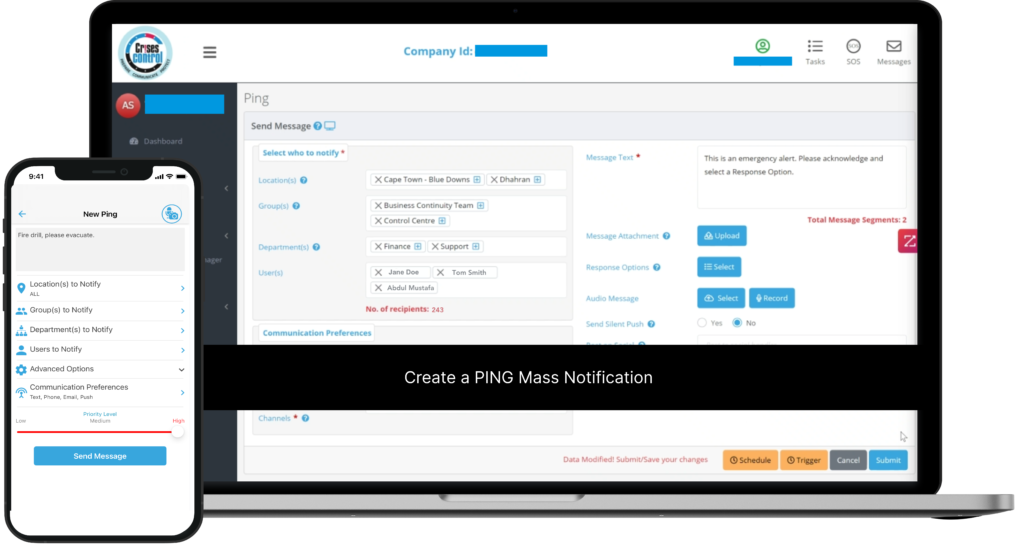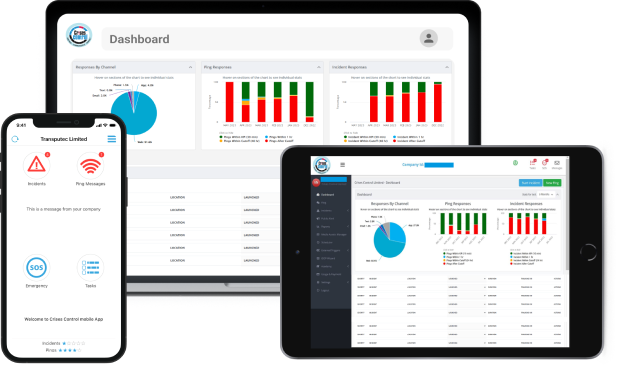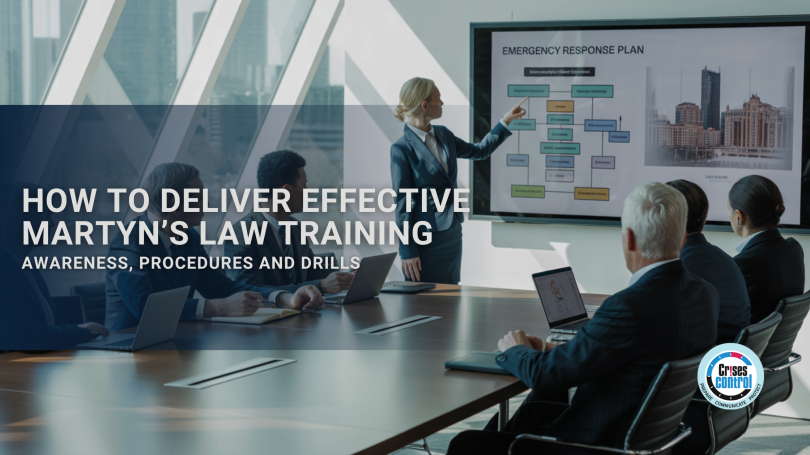Written by Anneri Fourie | Crises Control Executive
Introduction: The Real Cost of Being Unprepared
When a terrorist attack happens, there’s no time to plan your response. People need to act quickly and confidently, and that only comes from preparation. Unfortunately, many organisations, especially those responsible for public spaces or high-footfall venues, simply aren’t ready.
The 2017 Manchester Arena bombing was a tragic example of what can go wrong when teams are unsure of their roles or communication breaks down. In response to this, Martyn’s Law, also known as the Protect Duty, was developed to make sure organisations take the risks of terrorism seriously and prepare properly.
The law puts legal duties on venues to assess the risks and take action to reduce harm. One of the key parts of that action is training. But knowing what kind of training to provide, how to deliver it, and how to measure its effectiveness can be a challenge, especially for teams without in-house security expertise.
In this guide, we’ll explain what Martyn’s Law training involves and how to build it around three essential pillars: awareness, procedures, and drills. We’ll also look at how platforms like Crises Control can help you run simulations, test your plans, and support your team before a real incident ever happens.
Why Martyn’s Law Training Isn’t Optional
Martyn’s Law applies to venues with a capacity of over 100 people (standard tier) or over 800 (enhanced tier). It requires those responsible for these spaces to identify and assess terrorism risks, take proportionate and practical steps to reduce those risks, and ensure staff are trained to respond effectively.
That last point, training, is often underestimated. It’s not enough to send out a policy document or run a quick online course. Real preparedness comes from understanding how an incident might unfold and being ready to respond in the moment.
A good training programme should give staff the tools to:
- Recognise potential threats
- Act with confidence in a crisis
- Follow procedures without delay
- Protect themselves and others
Let’s break this down further.
Awareness: Knowing What to Look For
The first step in training staff is helping them to become aware of threats before they happen. Terrorism doesn’t always look like we expect it to. Suspicious behaviour, unattended items, or someone trying to access a restricted area can all be early warning signs.
Awareness training should help staff:
- Understand different types of attack (such as vehicle, knife, or bomb threats)
- Notice unusual behaviour or items
- Know how and when to report concerns
- Feel confident enough to act
One of the biggest risks during a developing incident is hesitation. People may fear they’re overreacting or feel unsure whether something is worth reporting. Training removes that doubt by building knowledge and confidence.
Crises Control can help you deliver updates, share learning materials, and keep awareness high using targeted communications. Whether it’s pushing out short videos, government alerts or internal briefings, the platform ensures information reaches the right people quickly.
It’s not about creating a culture of fear. It’s about encouraging people to trust their instincts and speak up when something feels off.
Procedures: What Happens in a Real Emergency?
Knowing there’s a risk isn’t enough. People also need to know what to do if a threat becomes real.
That means having clear procedures in place, which are understood by everyone, not just senior managers. In an actual emergency, there won’t be time to check a handbook. Staff need to know instinctively:
- Whether to evacuate or go into lockdown
- Where the safest routes and exits are
- Who to alert and how
- How to stay in touch during an incident
The difficulty is that emergencies are messy. Panic can set in, messages can be missed, and roles can be forgotten. That’s where technology comes in.
Crises Control’s mass notification system lets you send alerts instantly to everyone who needs them. Messages can be customised in advance and triggered with just a few clicks. You can reach people through multiple channels at once: app alerts, SMS, email, Microsoft Teams, and even voice calls.
This kind of system ensures that procedures aren’t just written down, they’re acted on, even in chaotic situations. Crises Control also enables you to trigger workflows, so your emergency plan is set in motion automatically: roles are assigned, actions logged, and communication lines kept open.
Drills and Exercises: Turning Knowledge into Habit
Even the best-written emergency plan is only useful if people know how to follow it. That’s why drills are a vital part of Martyn’s Law compliance.
A good drill does more than test your team, it strengthens your plan.
Your exercises should be:
- Frequent enough to keep procedures fresh (ideally every few months)
- Realistic, based on actual risks your venue might face
- Evaluated carefully to highlight areas for improvement
This is where Crises Control adds real value. While we don’t deliver the training itself, we can help you run crisis simulations and tabletop exercises with your crisis management team. These exercises test your plans in a controlled setting, helping you identify gaps and rehearse decision-making.
You can simulate everything from suspicious packages to coordinated attacks, then use the platform to:
- Track participation
- Monitor how quickly teams respond
- Collect real-time feedback
- Generate post-incident reports
This feedback loop helps you improve your processes and demonstrate compliance.
Building a Training Programme That Works
Effective Martyn’s Law training is not a one-off session. It needs to become part of how your organisation thinks and works.
1. Blend Learning Styles
Some people prefer online courses, while others benefit from in-person sessions. Mix things up with a combination of learning materials, live drills, tabletop exercises and scenario discussions.
2. Make It Role-Specific
Reception staff, cleaners, catering teams and managers will all play different roles in an emergency. Tailor training so everyone knows what’s expected of them.
Crises Control lets you assign content and messages based on role, location or team, so training is relevant and targeted.
3. Keep a Record
You’ll need to prove that training has taken place and that your team knows what to do. Crises Control automatically logs all messages, drills and actions, creating a full audit trail. You can export reports at any time for inspections, reviews or insurance purposes.
Interested in our Ping Mass Notification Software?
Efficiently alert everyone in seconds at scale with our Mass Notification Software – PING, get the message out fast and ensure rapid response and recovery.

What Gets in the Way of Good Training?
Many organisations want to comply with Martyn’s Law, but face barriers like:
- Lack of time or internal expertise
- Difficulty reaching remote or shift-based staff
- No clear way to track progress or compliance
These are understandable challenges, but they don’t have to stop you.
Crises Control is designed to work alongside your existing systems. You don’t need to be a counter-terror expert, and you don’t need to start from scratch.
With the platform, you can:
- Roll out communications to all staff via mobile, desktop or app
- Set up and run realistic drills
- Track completion and engagement
- Gather insights to improve your response
How Crises Control Supports Your Preparedness
Crises Control is not a training provider, but it is a critical support tool for any organisation serious about compliance.
Here’s how we help you meet your Martyn’s Law obligations:
- Mass Notification System: Deliver emergency instructions instantly across multiple channels.
- Drill and Simulation Management: Run and evaluate tabletop exercises or live scenario simulations for your CMT.
- Audit-Ready Reporting: Keep track of drills, alerts and communications for inspections or internal reviews.
You stay in control of your training programme, and Crises Control gives you the tools to make sure it works when it matters most.
Conclusion: Prepare Now to Protect Lives Later
Martyn’s Law is a wake-up call. It isn’t just about ticking a legal box, it’s about preventing real tragedies by preparing properly.
When your staff know what to look for, understand their roles, and have rehearsed their response, you give them the best chance of acting quickly and calmly in a crisis. That’s how lives are saved.
Crises Control helps you build this kind of resilience with simple, effective tools that make emergency planning more manageable.
Book Your Free Demo
Want to see how Crises Control can support your crisis response and preparedness strategy? Book a free demo today and take a step closer to full compliance and confident readiness.
Request a FREE Demo

